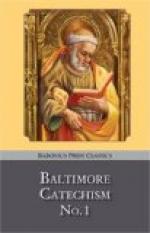The first plague was blood. All the water in the land was converted into blood. (Ex. 7). The king then sent for Moses and promised that if he would take away the plague he would allow all the people to depart. Moses prayed to God, and the plague was removed. But after it was taken away the king’s heart was hardened again and he would not keep his promise. Just as people in sickness, distress, or danger sometimes promise God they will lead better lives if only He will help them, and when they are saved they do not keep their promises, so did Pharao; and therefore God sent another plague. The second plague was frogs. Great numbers of them came out of the rivers and lakes, and filled all the houses of the Egyptians, and crawled into their food, beds, etc. Again the king sent for Moses and did as before; and again Moses prayed, and all the frogs went back into the waters or died. (Ex. 8). But the king again hardened his heart and did not keep his promise. The third plague was sciniphs (Ex. 8)—very small flies, that filled the land. Imagine our country filled with mosquitoes so numerous that you could scarcely walk through them; it would be a dreadful plague. As it is, two or three might cause you considerable annoyance, and pain: what then if there were millions doubly venomous, because sent to punish you? So these little flies must have greatly punished the Egyptians. The fourth plague was flies that filled the land and covered everything, to the great disgust of the people. The fifth plague was murrain—a disease that broke out among the cattle. The sixth plague was a disease—boils—that broke out on men and beasts, so that scarcely anyone could move on account of the pains and suffering. The seventh plague was hail, that fell in large pieces and destroyed all their crops. The eighth plague was locusts. These are very destructive little animals. They look something like our grasshoppers, but are about two or three times their size. They fly and come in millions. They come to this country in great numbers—almost a plague—every fifteen or twenty-five years, and the farmers fear them very much. They eat up every green blade or leaf, and thus destroy all the crops and trees. When the locusts came upon Egypt, Moses, at the king’s request, prayed, and God sent a strong wind that swept them into the sea, where they perished in the water. The ninth plague was a horrible darkness for three days in all the land of Egypt. The tenth plague, the last, was the most terrible of all—the killing of the firstborn in all the land of Egypt. (Ex. 12). God instructed Moses to tell the Israelites in the land that on a certain night they were to take a lamb in each family, kill it, and sprinkle its blood on the doorposts of their houses. They were then to cook the lamb and eat it standing, with their garments ready as for a journey. (Ex. 12). The lamb was called the paschal lamb, and was, after that, to be eaten every year, at about what is with us Easter-time,




